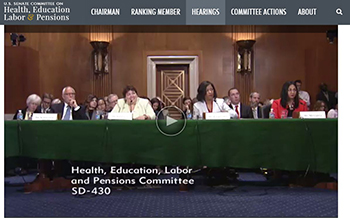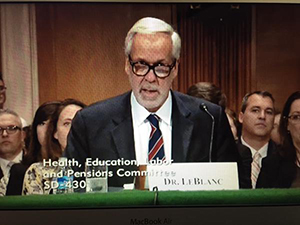This summer the Senate HELP (Health, Education, Labor & Pensions) Committee has begun the process of reauthorizing the Higher Education Act of 1965. As some of you have experienced in previous reauthorizations, the committee has been holding hearings to determine what key factors of the Act that need updates. Through modern technology I have been able to watch the hearings from my little office in the outskirts of Bozeman, MT and am happy today to bring you a little bit of what I’ve learned—three A’s are driving this round of reauthorization – Access, Affordability, and Accountability.
Consumer Information
 In the first of the spring hearings, the Committee addressed the issue of consumer information in college choice – what do students want and need to know? As Senator Alexander pointed out, it’s been said that the U.S. Department of Education does a far better job of collecting data about colleges than they do of disseminating that information to students in a manner that makes sense to them. The current vehicle for sharing that data is College Navigator, which can be hard for students to navigate and understand. The witnesses also stressed that any consumer information produced must include information on sub-baccalaureate degrees. And that we need to battle the fixation to only provide data at the institutional level — program level data is the most helpful for students to make informed choices about their postsecondary education options. During this hearing, a recent student talked about how a chance encounter with a poster at a YWCA is what led her to a program which helped her gain the confidence to enroll and complete college. She stressed, as did others on the panel, that having caring counselors at teh disposal of students who can help them translate what higher ed jargon means is extremely important to the success of especially first-time, first-generation students.
In the first of the spring hearings, the Committee addressed the issue of consumer information in college choice – what do students want and need to know? As Senator Alexander pointed out, it’s been said that the U.S. Department of Education does a far better job of collecting data about colleges than they do of disseminating that information to students in a manner that makes sense to them. The current vehicle for sharing that data is College Navigator, which can be hard for students to navigate and understand. The witnesses also stressed that any consumer information produced must include information on sub-baccalaureate degrees. And that we need to battle the fixation to only provide data at the institutional level — program level data is the most helpful for students to make informed choices about their postsecondary education options. During this hearing, a recent student talked about how a chance encounter with a poster at a YWCA is what led her to a program which helped her gain the confidence to enroll and complete college. She stressed, as did others on the panel, that having caring counselors at teh disposal of students who can help them translate what higher ed jargon means is extremely important to the success of especially first-time, first-generation students.
Skin in the Game
In the second hearing the Committee explored the idea of institutional risk sharing in student loan defaults. By this they are proposing that institutions will be held accountable for a portion of the student loans from their students that go into default. Douglas Webber, a professor at Temple University made the point that his research suggested that if institutions were to assume some of this risk, tuition would raise an estimated 1 -2 %. There was also a lot of talk of limiting the ability of students to borrow more than what tuition and fees are, especially for part-time students. How this affects you, our members, if the committee limits the use of student loans for living expenses for part-time students, it’s a short, slippery slope to cutting the ability for online students, even full-time, to receive student loans to cover living and miscellaneous expenses.
Affordability
In the third hearing, the HELP committee approached the topic of affordability directly. Several of the experts attested to the burden of the FAFSA and advocated for paperwork simplification. With simpler processing they suggested reallocating those counselors who help students fill out the paperwork for the more challenging and important task to advising students on academics and counseling them on financial planning/understanding what their loans mean. They also talked about the shrinking state contributions to higher education and how the federal government can incentivize states to continue to contribute to higher education. This had both sides through the carrot of less regulation and the stick of more regulation, depending on which side was talking. Otherwise as one person said, we’ll end up with a federal system of higher education rather than a state system of higher education.
Accreditation’s Role in Ensuring Quality
During this fourth hearing, which focused on accreditation’s role in ensuring quality, it’s important and interesting to note that there were NO regional accreditors on the expert panel testifying at the hearing. Three of the witnesses, Peter Ewell, George Pruitt (President of Thomas Edison State College), and Albert Gray (CEO of the Accrediting Council for Independent Colleges and Schools) advocated for change not, in Peter’s words “blowing up” the current accreditation system. Pruitt suggested that we should divorce the quality assurance portion of accreditation and the compliance work the accrediting agencies are mandated to do by the Department of Ed.
Anne Neal, the American Council of Trustees and Alumni, said we should blow up accreditation and let the Department of Ed decide if a subset of ‘known entities’ are producing quality without accreditation (think Harvard, big 10, etc.) She suggested a model like LEED certification for higher education accreditation – voluntary, market-based and not the gatekeeper for federal dollars. To me, this sure sounds like the accountability efforts which emerged after the Spelling’s Commission report in 2006 – Voluntary System of Accountability, Transparency by Design, UCAN, and Voluntary Fr amework of Accountability… If you ask the average student on the street, from my experience, they would not be able to name any of these.
amework of Accountability… If you ask the average student on the street, from my experience, they would not be able to name any of these.
Exploring Barriers and Opportunities Within Innovation
In the fifth hearing, the witnesses were: Mr. Jamie P. Merisotis President And Chief Executive Officer Lumina Foundation; Dr. Barbara Gellman-Danley President Higher Learning Commission; Dr. Paul J. LeBlanc President Southern New Hampshire University; Mr. Michael B. Horn Co-Founder And Executive Director, Education Programs Clayton Christensen Institute. As this was the hearing on innovation, there was quite the robust twitter backchannel during this hearing. I Storify‘d the tweets, if you’re interested.
The take away learning from this session:
- Gellman:
- Good innovation cannot be legislated. Legislators need to step back & allow creative people to do their good work. Remove the regulatory/compliance barriers on accreditors and they can better assess innovative programs.
- There are over 100 regulatory statues that govern the business of accreditation.
- LeBlanc:
- Title 1 constrains innovation because of the language related to ‘regular & substantive contact with faculty’ that was written in a time before the internet to distinguish correspondence courses from other offerings.
- Title 4 is a barrier because all of its timeline restrictions such as disbursements are tied to the credit hour. Competency-based education is trying to break the dependence on time as a measure of learning.
- Focus on outcomes, rigorous assessments & transparency, demand focus on outcomes not inputs. Create safe innovation spaces for institutions and for accreditors.
- The accreditation site visit is antiquated — looking at the data analytics for a program is what should be happening now, that’s where you can really see the outcomes.
- He expressed over and over again, just assigning experimental sites without evaluation and sharing of the learning is a waste and won’t move us in the direction we need to go.
- Merisotis:
- Today’s student is nothing like the student of 1965.
- Put student learning at the center. Defining clear student outcomes will allow competition to emerge and bring costs down.
- We’re all for affordability, however none of us have a common definition of what affordability means.
- Horn:
- Disruptive innovation is the process that makes services more afforadable and accessible to all.
- Disruptive innovation often happens in those spaces where the choice is really no choice at all. It happens in marginalized places/populations. Shared the example of Learn Up started by two guys who had spent 6 months in the unemployment lines hearing what others in line were expressing as barriers to employement (primarily job skills training and setting yourself apart to get an interview).
Basically if I were to boil down this hearing into a sentence it would be this: Higher education innovation needs to focus on outcomes, not inputs, utilizing rigorous, authentic assessments and share their results transparently in order to prove its quality so accreditors and legislators can feel confident the aid dollars directed at said programs are being well spent.
Opportunities to Improve Student Success
In this final hearing up to this point in the process, the committee looked at ways to improve student success. The first question this hearing raised for me, and was danced around during the hearing, is what is success and who defines it? If we think narrowly, then it revolves around graduation/completion rates. But if we think more broadly, what does success cover? Testimony at yesterday’s hearing encouraged the committee, and the higher ed community, to consider the breadth of student success, NOT just traditional degrees – industry credentials (certifications, nanodegrees, etc) are important for a key factor for students – employability.
Another point that was made directly and supported by various examples is that our students live on the edge – a transmission problem can force a student to drop out for a semester or for good. Modern students drop out because life happens, not because of an academic deficiency. Georgia State University shared the example of giving small grants, usually only a few hundred dollars, to help students get through those tough times to graduation. In order to do that, they have to use their data proactively. Analytics help identify a problem but the high-touch practices at Georgia State are what have made the most difference for students. They have to go hand in hand – in order to be as effective as possible.
Related to the first ‘A’ – it was noted that an open door becomes a revolving door quickly – student swirl is a barrier to timely progression for most students. Aiding this swirl is the lack of articulation agreements, even within state systems, that cause students to lose credits as they move around – incentivizing states to work on articulation could help this.
Finally, as Rachel Fishman tweeted during the hearing – Our #highered system & finance are complex, you can throw more info at the problem, but it won’t solve underlying issue: complexity. #Simplify.
They concluded reiterating their plan to have a draft for the whole committee review by “early Fall” and that the next meeting regarding the reauthorization of the higher ed act will be in September.
We will continue to track the issue and bring you insights as the reauthorization process continues!
 Cali Morrison
Cali Morrison
Manager, Communications
WCET
@calimorrison

 amework of Accountability
amework of Accountability
1 reply on “Three A’s Driving the Reauthorization of the Higher Education Act”
Cali,
Thanks for the great synopsis.